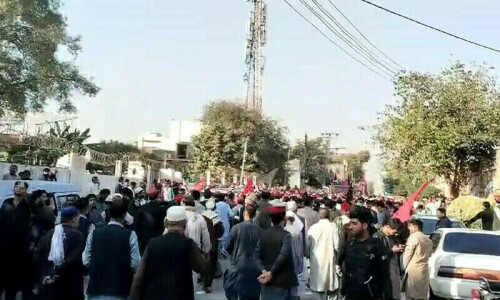HYDERABAD, June 29: Environmentalists, water experts and landowners fear the Right Bank Outfall Drain will be a repeat of the Left Bank Outfall Drain, which has repeatedly wreaked havoc in Badin and Mirpurkhas districts.
They said at a consultation workshop on drainage crisis organised by the Actionaid, an NGO, at a local hotel here on Sunday that the Environmental Impact Assessment (EIA) carried out for the RBOD was silent on very crucial questions about the drain’s impact on environment, community welfare and underground aquifers.
Naseer Memon, an environmental expert, criticised authorities for poor EIA for the project, saying “the most important of all is the social impact assessment, which has been defined in just three lines in the EIA.”He said the assessment did not mention effects of hill torrents on the drain and details about ecology of Gharo Creek through which it would fall into the sea.
He said that the link with which the drain would be connected reversed flow of water up to 10 kilometres during high tide. The aquifers, which were source of already shrinking freshwater, were likely to be affected but no studies had been carried out on the question. “The EIA shouldn’t have been approved by the EPA yet it has been done,” he said.
He said that now saline water of Balochistan would be discharged into RBOD as well which had not been planned earlier. Certain measures that could have been taken at the upstream had not been taken so far, like treatment of industrial effluent, he said.
Nazeer Memon, another environmentalist, said that the RBOD would lead to seepage and make water of River Indus hazardous. About 5.4 million acres of land out of 120 million cultivable land in the province had already become waterlogged, he informed.
Dr Ali Arsalan of PILER observed that funds for aid projects were used without transparency and accountability and called for a national political action focussing on people’s consent for such projects.
He blamed local consultants and contractors for supporting bad projects and persuading the government to execute them.
Ali Gul Chachar, an activist representing people affected by land acquisition for the RBOD, said that the RBOD would take up around 11,000 acres and was likely to render 60,000 acres more barren. He said that 5,000 families had been directly affected by the drain.
He said that the drain also posed threat to KB Feeder and complained that the compensation for land did not match even the price of its one acre yield.
Mustafa Mirani of Fisherfolk Forum said that he had been told by two engineers that since RBOD could not be completed on time the drain’s water would now be discharged into Nai Baran.
The participants of the workshop expressed fear that the LBOD would remain faulty because even its redesigning project had faults and said that people were objecting to the project when it was in its designing phase but neither officials nor landlords listened to them as the latter were busy claiming compensation for their barren lands.
Comrade Hussain Bux Thebo said that the drainage projects had been designed in violation of nature and in sharp contrast to basic principles of drainage.














































Dear visitor, the comments section is undergoing an overhaul and will return soon.